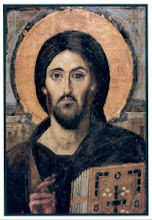Thursday, March 19, 2009
A Journey through Christendom's Most Holy time of Year
The Liturgical Season of Lent:
Lent is the season of prayerful journey and self-reflection. It is the forty days plus the six Sundays of preparation and self-denial that lead up to Easter. For centuries, Lent has been observed as a special time of personal examination and penitence. Today we find ourselves in a barren season that beacons us to concentrate on our fundamental Christian values and priorities. Contrary to the views of many, the season of Lent is not a time for self punishment; instead it is a time of letting go of those things that cut us off from God. Lent is a time in our spiritual lives in which we are called by God to prepare our hearts for the redeeming love of Christ.
Perhaps we find ourselves living in this world as one of the many aimlessly lapsed Christians, wandering away from church and neglecting our spiritual lives. For centuries, Lent has offered God's people the opportunity to return to the fellowship of the church. In fact the season of Lent historically is a period in the life of the church in which the lapsed, as well as those who have committed notorious sins were received back into the community of faith. If you are questioning your own faith and wondering what to believe, this is a most appropriate reflect and ask the difficult questions with sincerity and truth. For some Lent is a pathway that leads back into the Body of Christ or the Church.
Throughout Lent, the worship services of the church take on a simpler tone, appropriate to this season. Crosses showing the risen Christ are veiled. The word "Alleluia" is not used in the words of the liturgy or hymns. These practices help the worshipping community to mark this season of renewal as a special time in the church year.
Observing a Holy Lent ~ The custom is to mark the season of Lent by giving up some things and taking on others. Both can serve to mark the season as a holy time of preparation. Some examples of things people give up for Lent include sweets, meat for all or some meals, and alcohol. In most cases, giving up something for Lent can be made more meaningful by using the money or time for another purpose. For example, meal times on fast days could be spent in prayer. Another example is that if you give up meat during Lent, the extra money that would go to meat dishes can be given to a group, such as World Vision, which works to end hunger worldwide. Some things added during Lent are daily Bible reading, fasting on Fridays, times of prayer, taking a course of study related in some way to spirituality.
Note that the season of Lent is forty days plus the six Sundays. This is because Sundays are celebrations of Jesus’ resurrection and are always an appropriate day to lessen the restrictions of Lent. So that if you have, for example, given up chocolate for Lent, you could indulge in a weekly candy bar on Sunday.
The Sacrament of Confession ~ Lent is also an especially appropriate time for the sacrament of confession. While confession to a priest is not required to receive God’s forgiveness, it can be a meaningful rite of reconciliation to God.
Special Days and Services:
Shrove Tuesday ~ This is actually the day before Lent begins. The day is named for the "shriving" or confessing that was traditional on this day before beginning Lent. This day is also known as Maddi Gras, or "Fat Tuesday," because it was a time for eating the things from which one would abstain during Lent. Pancake suppers are traditional as they were a way of using up some of the ingredients not needed during Lent.
Ash Wednesday ~ The first day of Lent is marked with a special liturgy. The theme for the day, though not for all of Lent, is that we stand as sinners condemned to die, but for God’s grace. This is symbolized by the imposition of ashes on the forehead, with the words, "You are dust and to dust you shall return." In the Old Testament, ashes were a sign of penitence (feeling regretful at offenses) and mourning.
Ash Wednesday is one of two days of special observance (the other being Good Friday) for which fasting is recommended. While this usually refers going without food for the entire day, this practice is not practical for all persons, including, but not limited to, diabetics. Use your own discretion in determining how you can best observe this day.
Stations of the Cross ~ These are depictions of 14 incidents in the Gospel accounts of Jesus’ death from Pilate’s house to being placed in the tomb. They are used for the service called the Way of the Cross, which visits each station in turn with a brief reading, response, collect and on some occasions, a meditation. This is particularly appropriate for Good Friday.
Palm Sunday ~ This Sunday before Easter is the last Sunday in Lent. The day commemorates Jesus’ triumphal entry into Jerusalem with a blessing of palms and a procession in which the whole congregation carries palms. The day is also marked by reading the story of Jesus’ passion (the word used to describe Jesus’ death comes from "suffering," which is one old meaning of passion).
Maundy Thursday ~ This is the Thursday in Holy Week (the week leading up to Easter). The day is a time for remembering The Last Supper. The name comes from the Latin word "Maundatum" for "commandment" as Jesus said, "I give you a new commandment; that you love one another." This is also the moment in which Jesus showed his disciples the meaning of servant hood by washing their feet. We will observe the foot washing during the liturgy. At the conclusion of this service, altars are stripped of any ornamentation and crosses are removed or veiled to mark the solemnness of the occasion.
Good Friday ~ The Friday in Holy Week is a time for remembering Jesus death. Traditionally there is a Good Friday service at noon as Jesus hung on the cross from noon until 3 p.m. This is the second day of special observance for which fasting is recommended. One should use discretion in decided how best to observe this day. There is no celebration of Communion from Maundy Thursday until the Easter Vigil on late Saturday or early Sunday. However, it is customary in many churches to give out the elements of communion blessed during the Maundy Thursday service.
The Easter Vigil ~ This service is appropriate from after sunset on Holy Saturday until sunrise Easter morning. This is our most ancient Christian Liturgy. In the early Christian Church it was the traditional time of baptism, reaffirmation and reconciliation. This service begins in darkness and a new fire is lit, from which the Christ candle is lighted. It signifies the light of Christ coming into the world anew at the resurrection. This service ends the season of Lent and begins the joy of the Easter season.
Lent is the season of prayerful journey and self-reflection. It is the forty days plus the six Sundays of preparation and self-denial that lead up to Easter. For centuries, Lent has been observed as a special time of personal examination and penitence. Today we find ourselves in a barren season that beacons us to concentrate on our fundamental Christian values and priorities. Contrary to the views of many, the season of Lent is not a time for self punishment; instead it is a time of letting go of those things that cut us off from God. Lent is a time in our spiritual lives in which we are called by God to prepare our hearts for the redeeming love of Christ.
Perhaps we find ourselves living in this world as one of the many aimlessly lapsed Christians, wandering away from church and neglecting our spiritual lives. For centuries, Lent has offered God's people the opportunity to return to the fellowship of the church. In fact the season of Lent historically is a period in the life of the church in which the lapsed, as well as those who have committed notorious sins were received back into the community of faith. If you are questioning your own faith and wondering what to believe, this is a most appropriate reflect and ask the difficult questions with sincerity and truth. For some Lent is a pathway that leads back into the Body of Christ or the Church.
Throughout Lent, the worship services of the church take on a simpler tone, appropriate to this season. Crosses showing the risen Christ are veiled. The word "Alleluia" is not used in the words of the liturgy or hymns. These practices help the worshipping community to mark this season of renewal as a special time in the church year.
Observing a Holy Lent ~ The custom is to mark the season of Lent by giving up some things and taking on others. Both can serve to mark the season as a holy time of preparation. Some examples of things people give up for Lent include sweets, meat for all or some meals, and alcohol. In most cases, giving up something for Lent can be made more meaningful by using the money or time for another purpose. For example, meal times on fast days could be spent in prayer. Another example is that if you give up meat during Lent, the extra money that would go to meat dishes can be given to a group, such as World Vision, which works to end hunger worldwide. Some things added during Lent are daily Bible reading, fasting on Fridays, times of prayer, taking a course of study related in some way to spirituality.
Note that the season of Lent is forty days plus the six Sundays. This is because Sundays are celebrations of Jesus’ resurrection and are always an appropriate day to lessen the restrictions of Lent. So that if you have, for example, given up chocolate for Lent, you could indulge in a weekly candy bar on Sunday.
The Sacrament of Confession ~ Lent is also an especially appropriate time for the sacrament of confession. While confession to a priest is not required to receive God’s forgiveness, it can be a meaningful rite of reconciliation to God.
Special Days and Services:
Shrove Tuesday ~ This is actually the day before Lent begins. The day is named for the "shriving" or confessing that was traditional on this day before beginning Lent. This day is also known as Maddi Gras, or "Fat Tuesday," because it was a time for eating the things from which one would abstain during Lent. Pancake suppers are traditional as they were a way of using up some of the ingredients not needed during Lent.
Ash Wednesday ~ The first day of Lent is marked with a special liturgy. The theme for the day, though not for all of Lent, is that we stand as sinners condemned to die, but for God’s grace. This is symbolized by the imposition of ashes on the forehead, with the words, "You are dust and to dust you shall return." In the Old Testament, ashes were a sign of penitence (feeling regretful at offenses) and mourning.
Ash Wednesday is one of two days of special observance (the other being Good Friday) for which fasting is recommended. While this usually refers going without food for the entire day, this practice is not practical for all persons, including, but not limited to, diabetics. Use your own discretion in determining how you can best observe this day.
Stations of the Cross ~ These are depictions of 14 incidents in the Gospel accounts of Jesus’ death from Pilate’s house to being placed in the tomb. They are used for the service called the Way of the Cross, which visits each station in turn with a brief reading, response, collect and on some occasions, a meditation. This is particularly appropriate for Good Friday.
Palm Sunday ~ This Sunday before Easter is the last Sunday in Lent. The day commemorates Jesus’ triumphal entry into Jerusalem with a blessing of palms and a procession in which the whole congregation carries palms. The day is also marked by reading the story of Jesus’ passion (the word used to describe Jesus’ death comes from "suffering," which is one old meaning of passion).
Maundy Thursday ~ This is the Thursday in Holy Week (the week leading up to Easter). The day is a time for remembering The Last Supper. The name comes from the Latin word "Maundatum" for "commandment" as Jesus said, "I give you a new commandment; that you love one another." This is also the moment in which Jesus showed his disciples the meaning of servant hood by washing their feet. We will observe the foot washing during the liturgy. At the conclusion of this service, altars are stripped of any ornamentation and crosses are removed or veiled to mark the solemnness of the occasion.
Good Friday ~ The Friday in Holy Week is a time for remembering Jesus death. Traditionally there is a Good Friday service at noon as Jesus hung on the cross from noon until 3 p.m. This is the second day of special observance for which fasting is recommended. One should use discretion in decided how best to observe this day. There is no celebration of Communion from Maundy Thursday until the Easter Vigil on late Saturday or early Sunday. However, it is customary in many churches to give out the elements of communion blessed during the Maundy Thursday service.
The Easter Vigil ~ This service is appropriate from after sunset on Holy Saturday until sunrise Easter morning. This is our most ancient Christian Liturgy. In the early Christian Church it was the traditional time of baptism, reaffirmation and reconciliation. This service begins in darkness and a new fire is lit, from which the Christ candle is lighted. It signifies the light of Christ coming into the world anew at the resurrection. This service ends the season of Lent and begins the joy of the Easter season.
Subscribe to:
Post Comments (Atom)
Trinity Wall Street Conference Center Chapel

Our prayers rise like incense into heaven
Church of the Good Shepherd, Augusta, Ga.

"...And the sun shall not strike you by day, nor the moon by night."

























No comments:
Post a Comment